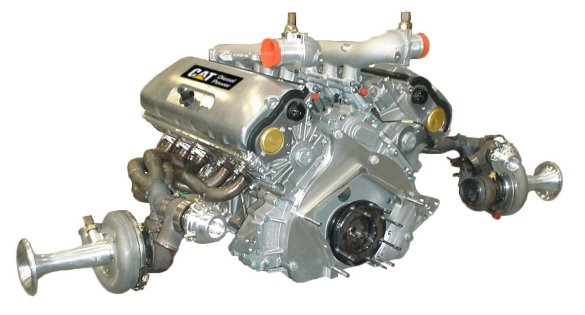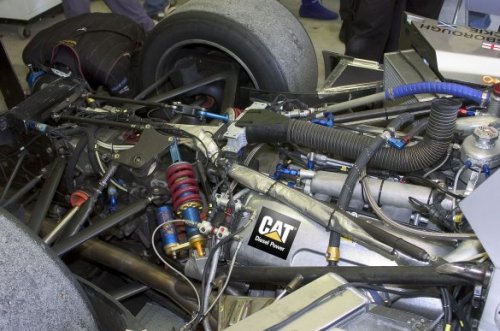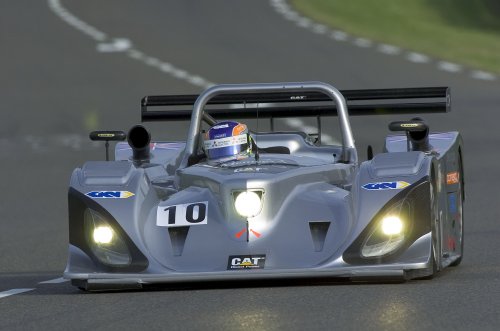24 Heures du Mans
The benefit of a Working Prototype
Since Le Mans, interest generated by our diesel LMP1 entry has been immense. From diverse applications of the existing V10, requests for evolution of the V10, clean sheet designs to win Le Mans in X years to engineering support in the development of racing diesels. PTeC has been swamped by opportunities. Please find below the story behind the 5 months of hectic activity that has led to this interest.
The chief engineer of a leading, technology driven manufacturer was interviewed on Radio 4. He suggested that there is little value in an idea, but there is value in a working prototype.
Racing diesel powered passenger cars are becoming commonplace. Recently, many people have had the idea of a serious diesel engined racecar and to compound the challenge, suggested winning the LMP1 class in the 24 hour race at Le Mans. However, the financial investment suggested, for what is just an idea, were prohibitive.
Late in 2003, Taurus Sports approached Perkins with an idea - to use the VW 5.0 litre, V10 PDi engine as the basis of a diesel powered Lola racecar for entry in the 2004 Le Mans 24-hour race. Taurus is a very small race team so the aim was visionary but modest. Not to compete with the dominant teams (80 people with "a lunchbox budget greater than the Taurus race budget" as one pit-lane wag subsequently phrased it) but to challenge the second tier race teams including Taurus Sports own Judd powered Lola.
The concept of using a current engine appealed to Perkins for two reasons: it allowed participation at a modest level of investment and provided the opportunity to understand more about race engine technologies. Involvement was approved through PTeC, the consultancy business within the Perkins engineering division, and two technical specialists were assigned to the project.
In January 2004, PTeC reviewed the engine potential and set out to develop high, reliable, controllable power within the constraints imposed by the LMP1 formula that includes an intake air restriction.
Unrestricted engines rated at 313hp were procured from our local VW dealer, Cooks of Peterborough. The fundamentals of increased performance were achieved through combustion chamber geometry changes, fuel system modifications and a race specification turbocharger from our friends at Honeywell. The very experienced Mountune people addressed engine race preparation and fundamental package issues, including dry sump lubrication.

The race prepared engine featuring honeywell turobchargers and dry sump lubrication
Engine management in modern passenger cars, including alarm/immobilizers and On-Board Diagnostics is an inconvenience to those with a need to tinker. For those in need of radical horsepower, they are a serious hindrance. As such PTeC worked with our Caterpillar Electronics group colleagues on the control strategy and Pi Technology on the hardware to develop a bespoke Caterpillar owned ECM and injector driver system.
The heavily modified engine hit a test-bench for the first time at the end of February and produced 400hp within 3 days.
At the end of March the engine was in a green development chassis at Snetterton producing a controllable 425hp and ran for 40 laps with laptimes at 110% of the Judd-powered car.

The engine installed in a Lola development chassis
Taurus Sports were to compete the Judd car at round 1 of the LMP series at Monza, which led to a dilemma: delay the diesel development or develop in the public eye. The latter decision proved stressful when installation problems led to problematic qualifying and a failure to start the race due to flat batteries. However, over the weekend, the 500hp engine had been found to accept significant punishment.
After Monza, installation revisions were made and a return to Snetterton led to 100+ trouble free laps running at 104% of the Judd lap time and 2/3rds of the fuel consumption. The drivers commented that chassis development would provide significant gains but we only had Le Mans qualifying to go. Visible particulate emissions were still in evidence and anathema to our mandate.
Subsequent test bed development of the intake restricted engine pushed power above 525hp and reliability was proven for 24 hours of simulated racing. Our valued colleagues at Eminox were engaged in the specification and provision of a trap to control errant particulate emissions.
Le Mans practice & qualifying was hindered by a number of minor niggles and a clutch failure that left the car stranded on the circuit for the only time. According to the drivers, less than 4 minute laptimes were possible with a sorted chassis and in one session the diesel car was fastest through the speed trap at 292kph (with the fastest Audi at 288kph).

The flying carpet being put through its paces
9 laps into pre-race warm-up saw a transmission actuation failure and further clutch problems. After starting the race from the pit lane, a significant contingent of the knowledgeable crowd applauded as the car completed its first lap. The car moved up 12 places over the next 2 hours and 45 minutes with the traps providing very effective reduction of particulate emissions. One notable characteristic of the car was the absence of any significant noise, which earned the car the title "Le Tapis Volant", the flying carpet.
A further transmission failure and the subsequent clutch abuse to return the car to the pits in 4th gear, led to a decision to retire. The car was running 17 laps to a tank of diesel compared with 10-11 laps for the equivalent gasoline cars.
The problems experienced by the car are all well understood and with modest development time & money we will build upon the Le Mans promise.
The car has subsequently raced at the Silverstone 1000km race held on August 14th 2004. Click here for further details

